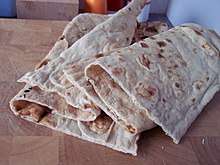Focaccia
Focaccia (Italian pronunciation: [foˈkattʃa]; Ligurian: fugassa [fyˈɡassa]) is a flat oven-baked Italian bread product[1] similar in style and texture to pizza dough. Focaccia can be used as a side to many meals or as sandwich bread.
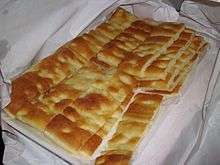 Focaccia Genovese | |
| Type | Flatbread |
|---|---|
| Place of origin | Italy |
| Main ingredients | High-gluten flour, oil, water, salt, yeast |
Focaccia al rosmarino (focaccia with rosemary) is a common focaccia style in Italian cuisine that may be served as an antipasto, appetizer, table bread, or snack.
Etymology and regional variants
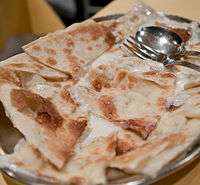
In Ancient Rome, panis focacius[1] was a flat bread baked on the hearth.[2] The word is derived from the Latin focus meaning "hearth, place for baking".[3] The basic recipe is thought by some to have originated with the Etruscans, but today it is widely associated with Ligurian cuisine.
As the tradition spread, the different dialects and diverse local ingredients resulted in a large variety of bread (some may even be considered cake). Due to the number of small towns and hamlets dotting the coast of Liguria, the focaccia recipe has fragmented into countless variations (from the biscuit-hard focaccia di Camogli to the oily softness of the one made in Voltri), with some bearing little resemblance to its original form. The most extreme example is a specialty called focaccia col formaggio ("focaccia with cheese") which is made in Recco, near Genoa. Other than the name, this Recco version bears no resemblance to other focaccia varieties, having a stracchino cheese filling sandwiched between two layers of paper-thin dough.[4]
Out of Liguria, focaccia comes in many regional variations and its recipe, its texture, its flavor remarkably varies from north to south of Italy. In some parts of the Northwest, for example, a popular recipe is focaccia dolce ("sweet focaccia"), consisting of a basic focaccia base and sprinkled lightly with sugar, or including raisins, honey, or other sweet ingredients.[5] Another sweet focaccia from the Northeast is focaccia veneta ("Venetian focaccia"), a typical cake of the Venetian Easter tradition: it is based on eggs, sugar and butter (instead of olive oil and salt) and it looks quite similar to panettone or to another Venetian cake like pandoro.
In South Tyrol and in the small village of Krimml in Austria, Osterfochaz (in Krimml Fochiz) is a traditional Easter gift from godparents to their godchildren. It is made slightly thinner in the centre so that dyed eggs can be placed there.[6]
Focaccia al rosmarino

Focaccia al rosmarino (focaccia with rosemary) is a common flatbread style in Italian cuisine that may be served as an antipasto, appetizer, table bread, or snack. Similar dishes include focaccia alla salvia (focaccia with sage), pizza bianca (white pizza) and potato rosemary focaccia, the latter of which is referred to as "potato pizza" in New York City. Like other focaccie, focaccia al rosmarino is sometimes considered to be a kind of pizza,[lower-alpha 1] though they are generally distinguished in Italy.[lower-alpha 2]
Overview
Focaccia al rosmarino is a popular style of flatbread[9] in Italian cuisine prepared using focaccia dough, rosemary, olive oil and salt, sea salt or kosher salt.[7][10][11][12] Focaccia al rosmarino may be served as antipasto (appetizer),[13][14][15] table bread or snack.[16] Whole or sliced fresh rosemary leaves may be used,[10] as can dried rosemary.[17] It may be garnished with sprigs of fresh rosemary after baking[11] and sprinkled with salt.[17]
Focaccia al rosmarino may have a moist texture, and the ingredients used in its preparation and the shape it is formed in varies in different regions.[9] It may be prepared as a savory or sweet dish.[9] The dish is typically baked, although it is sometimes fried in oil.[9] Rosemary is among the most common herbs used to flavor focaccia bread.[18] Additional ingredients such as garlic,[10] or basil may be used.[19] It is sometimes served accompanied with slices of prosciutto,[20][21] an Italian dry-cured ham. It can be prepared as a gluten-free dish[22] and as a vegan dish.[15] It may be used in the preparation of sandwiches.[12][23]
 Slices of focaccia al rosmarino
Slices of focaccia al rosmarino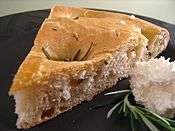 A close-up view of focaccia al rosmarino
A close-up view of focaccia al rosmarino
Similar styles
A very similar style is focaccia alla salvia (focaccia with sage), which is prepared by simply substituting sage for the rosemary.[11] Pizza bianca is another similar style, which is prepared using pizza dough, olive oil, chopped rosemary and salt.[24][25] The term "pizza bianca" refers to focaccia in some areas of Italy.[26]
Potato rosemary focaccia (focaccia con patate e rosmarino in Tuscany) is a variation that is referred to as "potato pizza" in New York City.[27] Pizza is also a similar dish.
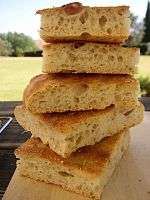 Focaccia con salvia (focaccia with sage)
Focaccia con salvia (focaccia with sage).jpg) Focaccia with rosemary and cheese
Focaccia with rosemary and cheese
See also
Notes
- "Focaccia with Rosemary; Yield: 1 (12-inch [30cm]) pizza"[7]
- "What is the main difference between pizza and focaccia? The flattening of the dough, how long you take to roll out the dough, as well as the cooking time. Focaccia sits and rises before being baked. It is only put in the oven when the dough finishes rising. Pizza is placed in the oven immediately." – Gabriele Bonci[8]
References
- "Panis focacius". Archived from the original on 2017-07-12. Retrieved 2008-12-30.
- "A Short History of Focaccia Bread". Big History. WordPress. Retrieved 2012-03-22.
- Oxford Latin Dictionary (Oxford: Clarendon Press, 1982, 1985 reprinting, p. 718.
- "Focaccia di Recco". Academia Barilla. Retrieved 9 November 2018.
- "Focaccia Bread". Archived from the original on 3 May 2012. Retrieved 22 March 2012.
- "Ostern". Familien feiern Feste. Retrieved 2018-09-24.
- Whitson, C.; Gjesteland, T.; Widen, M.; Hansen, K. (2015). Passion for Pizza: A Journey Through Thick and Thin to Find the Pizza Elite. Agate Publishing, Incorporated. p. pt419. ISBN 978-1-57284-746-0.
- Whitson, C.; Gjesteland, T.; Widen, M.; Hansen, K. (2015). Passion for Pizza: A Journey Through Thick and Thin to Find the Pizza Elite. Agate Publishing, Incorporated. p. pt73. ISBN 978-1-57284-746-0.
- The Illustrated Step-by-Step Cook. Look & cook. DK Publishing. 2010. pp. 392–393. ISBN 978-0-7566-7507-3.
- Bertoli, F.B.; Mauriello, F.M.R. (2011). From a Rectory Kitchen. XULON Press. p. 15. ISBN 978-1-61904-695-5.
- Orsini, G.; Orsini, J.E. (2007). Italian Baking Secrets. St. Martin's Press. p. 113. ISBN 978-0-312-35820-4.
- Deseran, S.; Weaver, J. (2013). Picnics: Delicious Recipes for Outdoor Entertaining. Chronicle Books LLC. p. 21. ISBN 978-1-4521-2848-1.
- "In via Saluzzo un locale consacrato al mollusco". La Stampa (in Italian). November 2, 2015. Retrieved March 4, 2016.
- Rossi, L.; Verdi, D.; Gialli, G. (2014). Ricette del giorno: Antipasti. Ricette del giorno (in Italian). Bibliotheka Edizioni. p. pt41. ISBN 978-88-98801-59-6.
- Klein, D.M. (2001). The Mediterranean Vegan Kitchen: Meat-free, Egg-free, Dairy-free Dishes from the Healthiest Place Under the Sun. HP Books. p. 191. ISBN 978-1-55788-359-9.
- Marcangelo, J.; Birch, C. (1984). Italian Vegetarian Cooking. Inner Traditions/Bear. p. 94. ISBN 978-0-89281-343-8.
- Desert Island Dishes. Infinite Ideas Series. Infinite Ideas. 2012. p. 32. ISBN 978-1-908984-16-6.
- Sauvage, J. (2015). Gluten-Free Wish List: Sweet and Savory Treats You've Missed the Most. Chronicle Books LLC. p. 59. ISBN 978-1-4521-4389-7.
- Barnett, A. (1996). Examining Food Technology. Examining Food Technology Series. Pearson Education. p. 44. ISBN 978-0-435-42062-8.
- Mib, Ftse. "Focaccia al rosmarino e prosciutto". Ticino News (in Italian). Retrieved March 4, 2016.
- "Spuntini veloci: focaccia con fichi e caprino" (in Italian). Blogo. September 20, 2011. Retrieved 4 March 2016.
- Bruce-Gardyne, L. (2011). How To Cook for Food Allergies: Understand Ingredients, Adapt Recipes with Confidence and Cook for an Exciting Allergy-Free Diet. Pan Macmillan. p. 186. ISBN 978-1-905744-94-7.
- Madison, D. (2014). The New Vegetarian Cooking for Everyone. Potter/TenSpeed/Harmony. p. pt391. ISBN 978-1-60774-554-9.
- Fraioli, J.O. (2009). Pizza & Wine: Authentic Italian Recipes and Wine Pairings. Gibbs Smith, Publisher. p. 81. ISBN 978-1-4236-1250-6.
- Simonis, D. (2010). Italy. Country Guide Series. Lonely Planet. p. 150. ISBN 978-1-74220-352-2.
- Riolo, A. (2012). The Mediterranean Diabetes Cookbook. American Diabetes Association. p. 260. ISBN 978-1-58040-483-9.
- Reinhart, P. (2010). American Pie: My Search for the Perfect Pizza. Potter/TenSpeed/Harmony. p. 235. ISBN 978-1-60774-090-2.
Further reading
| Wikibooks Cookbook has a recipe/module on |
| Wikimedia Commons has media related to Focaccia. |
- Pane, pizze, focacce e torte salate. Voglia di cucinare (in Italian). Giunti Demetra. 2010. p. 229. ISBN 978-88-440-3944-8.
